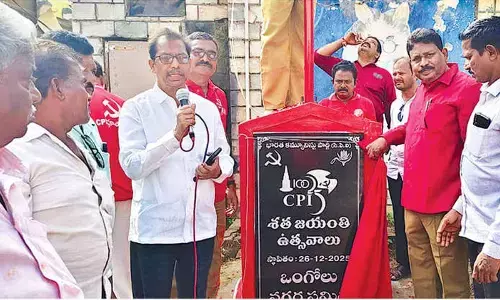Lessons from Assembly election: Assumptions and reality

Lessons From Assembly Election: Assumptions And Reality, Five States Assembly Elections Results. The visual media has reduced the massive electoral exercise into a spectator sport. With the upcoming Lok Sabha elections in mind, it billed the recent four-state Assembly elections as the semi-final, giving them the air of a football game.
 The visual media has reduced the massive electoral exercise into a spectator sport. With the upcoming Lok Sabha elections in mind, it billed the recent four-state Assembly elections as the semi-final, giving them the air of a football game. Since it has fallen for the Bharatiya Janata Party's ploy of casting the polls in the form of a presidential contest between Narendra Modi and Rahul Gandhi, the final may well turn out to be a mini-screen boxing bout.
The visual media has reduced the massive electoral exercise into a spectator sport. With the upcoming Lok Sabha elections in mind, it billed the recent four-state Assembly elections as the semi-final, giving them the air of a football game. Since it has fallen for the Bharatiya Janata Party's ploy of casting the polls in the form of a presidential contest between Narendra Modi and Rahul Gandhi, the final may well turn out to be a mini-screen boxing bout.Since conditions in the rest of the country differ vastly from those in these four states, it is risky to draw nationally valid conclusions from so-called semi-final.
Yet if one goes beyond the instant analyses provided by the channels, which were generally marked by professional deficiency and political bankruptcy, it is possible to detect changes in the political scenario which hold some lessons beyond what they found.
All the four states have been battlegrounds where the Congress and the BJP were in direct confrontation in successive elections. Delhi was with the Congress for 15 years at a stretch, and Madhya Pradesh and Chhattisgarh with the BJP for 10 years. Rajasthan regularly changed hands.
This time Delhi abandoned the Congress but did not end up in the BJP's hands as the newly formed Aam Admi Party threw the spanner in the Congress-BJP works. While both MP and Chhattisgarh opted to stay with the BJP for five more years, Rajasthan stuck to the pattern of alternating between the Congress and the BJP.
The change in Rajasthan was brought about by a drop of three percentage points in the Congress's vote share and a 12 percentage point rise in the BJP's. Beating the hyped anti-incumbency factor, the BJP boosted its vote share in MP by eight percentage points. The Congress, too, raised its vote share in the state by about four percentage points, which means the BJP did not gain at its expense. In Chhattisgarh, too, both the BJP and the Congress raised their vote share by two percentage points each.
In Delhi, there was a dramatic change in the Congress party's fortune. It suffered a massive fall of 15 percentage points in its vote share. The BJP too lost votes, its share slipping three percentage points. The AAP, on its debut, claimed an impressive 30 percent of vote share.
In all the states, the vote share of the small players dwindled. The chief sufferer was the Bahujan Samaj Party, which had shown signs of growth in earlier elections. This is a development that strengthens the trend towards a two-party system which was in evidence in the Hindi states where the Congress and the BJP are in direct confrontation.
For the present the AAP has altered the Delhi scenario by upsetting the emergent two-party system involving the Congress and the BJP. It is too early to say whether it will evolve into a multi-party state, like, say Uttar Pradesh, or return to the old pattern.
The AAP's performance is not unprecedented as excited young television anchors tried to project. In the 1980s, in Andhra Pradesh, the Telugu Desam Party founded by N.T. Rama Rao had made an even more spectacular performance. It not only stormed into power within nine months of its formation but went on to become the main opposition in the Lok Sabha on the strength of its 33 seats from the state.
A widely circulated newspaper had a big role in the TDP's stunning electoral debut. In this respect, a vague parallel can be drawn between the TDP and the AAP. Part of the credit for the AAP's impressive showing belongs to the channels which had boosted Anna Hazare's Jan Lokpal movement, which provided Arvind Kejriwal with the momentum to launch the AAP.
In some respects Delhi is a microcosm of India. But it is by no means typical of India. It is almost entirely urban. Only 2.50 percent of the state's population is classified as rural. No state or city, barring perhaps Mumbai, is under as much bombardment by television as Delhi is. Therefore, the chances of replication of the Delhi experiment nationally are not very bright.
There is, however, no denying that the AAP's emergence has created a new situation. Its campaign against corruption has evoked a good response in towns and cities across the country. This poses a problem mainly for the Congress and the United Progressive Alliance, which are facing graft charges, but, as the Delhi voting figures indicate, the BJP too is not immune from its effect.
The media assessment of Narendra Modi's contribution to the BJP's electoral performance deserves a close look. Its vote share gain of 12 percentage points in Rajasthan and eight percentage points in MP are above the normal range of swing in states where the two-party system has emerged. It can, therefore, be attributed to the Modi effect. Inasmuch as it did not manifest itself in Delhi, as evidenced by the drop in the party's vote share in that state, the assumption that Modi has a tremendous appeal among urban youth is open to question.
Next Story

















